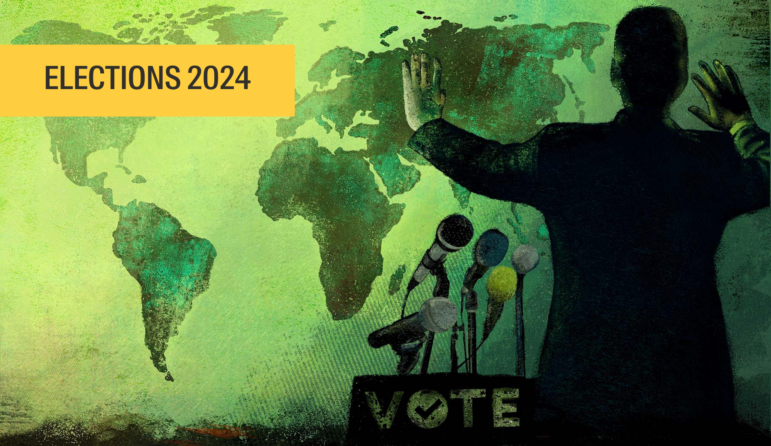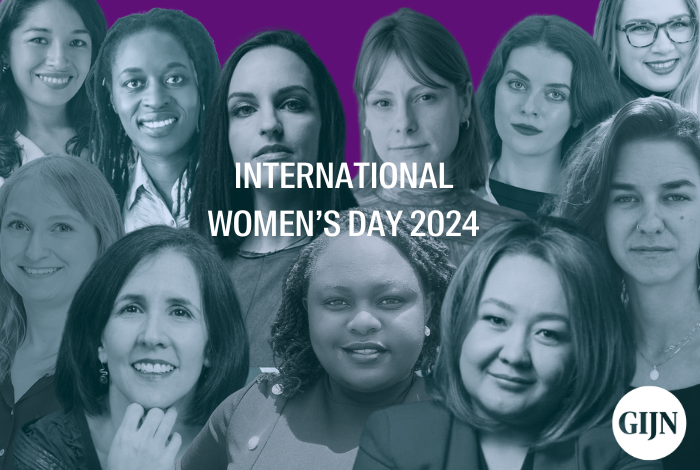

Image: Shutterstock
How Rest of World Tracks AI Use in 2024 Elections Around the Globe
As two billion people around the world head to the polls, a key concern for many has been the potential role new AI could play in election campaigns. This technology could worsen issues around disinformation or online harassment.
For now, and despite a few well-publicized instances, there isn’t yet a lot of evidence of AI playing a significant role in elections this year. But many news organizations will focus on votes in the US, the UK and the European Union, potentially leaving the Global South elections under-covered. Rest of World, a nonprofit online publication covering technology’s impact outside of the West, is aiming to address this problem with a new project, the 2024 AI Elections Tracker, which launched on April 16, 2024. (Here is an explainer on the tracker’s methodology.)
The tracker is an ongoing log of examples of AI being used around elections. Examples are flagged to the team, verified, and reported on before a summary is added to the tracker’s timeline, with the context and links to the original image, video, or post. I spoke to Victoria Turk, features director at Rest of World, who explains the project in her own words.
1. The Project in a Nutshell

Victoria Turk, features director at Rest of World. Image: Screenshot, Rest of World
Victoria Turk: The idea is to gather examples of AI being used in the context of elections globally. To give a bit of background, 2024 is a massive year for elections: we’ve got more than two billion people globally eligible to vote this year. This comes after a big boom in generative AI tools which are very accessible, things like ChatGPT, AI image generators, and audio and video tools.
There’s been a lot of discussion around what that could mean for democracy in terms of how these tools could be used or abused in campaigning and spreading misinformation and disinformation. We wanted to look at what’s actually happening and go beyond those theoretical concerns to see what’s happening on the ground. We are looking at how generative AI tools are being used around elections in countries worldwide.
2. The Problem They Wanted to Solve
VT: Everyone knows from a top-level perspective that generative AI tools are being used around elections. What we want to find out are the genuine instances of this happening, especially outside of the West. I think a lot of focus is on English-language content, maybe around the US elections and the UK elections. Western outlets in particular are looking less at the elections in Latin America, Africa, or Asia.
We’re keeping this going throughout the year and we’re hoping we’ll end up with a database of content which we can then look at to see overarching trends in the future. That database will be open to be used also by other people who can come back and see what’s happened in different places.
I should say we are not just focusing on the negative uses of these tools, so when people think about elections and generative AI, they think automatically about disinformation, misinformation, deepfakes, and intentionally misleading voters. We are seeing some of that, but there are also other creative uses of this technology. In some cases, we’re seeing political parties and campaigns using this tech to better reach voters, spread their campaign materials, and provide information.
We saw this from Imran Khan, the former Prime Minister of Pakistan: his party was using AI to enable him to give a video speech to his supporters even though he was imprisoned. In Belarus, we saw the opposition create an AI candidate powered by ChatGPT that could answer people’s questions in a way that might be dangerous for a real opponent in that political context.
We’ve also seen a lot of like fun stuff: memes and people either poking fun at the opposition or making celebratory memes around the candidates that they support and so we’re not taking a view on whether this is good or bad, we want to capture what is happening.
3. The Problems They Encountered
VT: A lot of this content is in local languages, so having journalists who speak that language and are familiar with the context is critical. We wouldn’t be able to do it without that knowledge. Verifying if something actually is AI is a big challenge and sometimes it is very obvious: often people will state that they have used AI to make something and they’re quite upfront about it; sometimes they’re even showing off that they’re adept at using these new tools.
In other cases, maybe they don’t admit to using AI or they’re trying to, in the case of deep fakes, pass off content as being legitimate when actually it’s falsified. In those cases, we have to do a bit of detective work to check if the content is AI-generated or not.
4. How They Found a Solution
VT: “So far, we’ve found that there’s no one-size-fits-all solution to do these checks. There are some tools out there that will give you a score as to how likely they think an image, a video or audio is to have been AI-generated, but I don’t think any of them are foolproof, so we’re using as many resources as we can.
We’ve been both using some of the online tools available, but also going directly to researchers in this space to get their view, and going to local fact-checking organizations to see what they think.
Sometimes that’s about looking for digital clues. So maybe the mouth movements don’t line up with the audio, which might suggest that the video has been tampered with. But it might be more contextual: if you know the local political situation, you know that it’s probably very unlikely that a particular instance, for example, shown in a video, actually happened and so you do some more traditional reporting to find out if the people pictured were in that spot at that time.
Also, from the start we built into the tracker an update possibility. We are aware that there may be cases where the story changes or we get more information about an entry and we feel that we need to add that information for our readers.”
5. How They Tested Their Tool
VT: We’ve launched with the initial idea that this is something that’s going to grow. We launched it with several incidents that took place from the beginning of January until the launch date on April 16. Now we are planning to update with new entries as we come across them. We are trying to be as responsive as possible.
We’re expecting to see the number of entries rise and fall in line with elections, so you’d expect to see a lot more content generated around a specific election when that occurs.
At the moment, most entries are about Indonesia, Pakistan, and Bangladesh because they have already had their elections. We are expecting to see more around the elections in Mexico and South Africa as those elections get closer in time. It’s a new format for us, it’s unusual in that it is one project that we are consistently working on and changing through the year, so it’ll be interesting to see how it develops.
A recent entry in Rest of World’s AI Election Tracker, which identified an X [Twitter] account posting a manipulated image of Mexican presidential candidate Xóchitl Gálvez that falsely portrays her waving the country’s flag upside down at a rally. Image: Screenshot, Rest of World.
6. How the Tool Works in Practice
VT: One of the things we have at Rest of World which I think is a real advantage over a lot of publications is a global team and a global network of contributors, so we’re leaning on that a lot to find and report on the entries for this tracker. We’ve got journalists in pretty much every region outside of the West. We don’t cover North America and Western Europe. We’ve got a network of contributors in different countries who have been tasked with looking for examples of AI being used in or around elections in their country.
They are pitching those examples to us and then reporting them out, verifying that AI has been used, trying to find the details of who’s doing it, why they are doing it, what tools they might be using, how the content is spreading, and they’re all feeding into one tracker. That’s important because a lot of this content might be in local languages, it might require knowledge of the local political context that one person sitting in one country is not going to have for everywhere around the world.
We are also working with other organizations in this space and we are encouraging people to share what they’re seeing with us, and we’re sharing back with them to make sure that we’re covering as many bases as we can.
Finally, we are also asking readers to submit examples that they see on social media. We are trying to get as many examples our way as possible so that we can then look into them and verify if they meet the criteria to be included in the tracker.
7. How the Tool Can Be Improved
VT: The first thing is just getting as many examples as we can, and we were really happy to see that even on the first day of launch we got a few reader-submitted entries to look into which is great because the more people are contributing, the more incidents we’re going to see and so keeping up that momentum is important to make this as useful as possible.
We are interested to see how people end up using it and to see what kind of content we’ve got. At the moment, it’s possible to filter content by month, by country, and by the platform we’re seeing it spread on. We are interested to see how useful that filtering technique is. Maybe that’s something that we can develop in the future.
One part of this that we thought was quite important from the start is saving the content that we’re talking about. A lot of this content may be removed either by the platforms or by the people who have put it out there in the first place. We think it’s really important to preserve the content so that it makes sense when people come back to look at it in the future and that they’re able to see exactly what it was. That’s something that we’re working on to include.
There may be cases where we decide not to show that content if we think it could cause particular damage. But in general, we want to build a library so that readers, researchers, and whoever might want to use this tool, have something to refer back to.
We’re also interested in tracking how platforms approach AI content around elections. Some have developed specific rules for this. Others are still working on those or changing them as they go. We want to track how different platforms respond to this content in terms of, do they take it down, or label it? Are we seeing particular phenomena on particular platforms? That’s something that we are trying to include in the entries as we go as well.
8. How This Can Help Newsrooms
VT: We’re just putting it all out so that people can see it all and use it for themselves. Other people who are writing about the phenomenon of AI around elections can have these examples to draw on. It could be a useful resource, with different publications focusing on different geographies or on specific technological trends who might want to look at the specific incidents that are relevant to them. The more entries we get, the more interesting data analysis might be possible by looking at the data en masse to see if particular trends reveal themselves.
This story was originally published by the Reuters Institute and is reprinted here with permission.
 Marina Adami works as a digital journalist at the Reuters Institute. Originally from Italy, she has reported on breaking news for Politico Europe in Brussels and on local news in London.
Marina Adami works as a digital journalist at the Reuters Institute. Originally from Italy, she has reported on breaking news for Politico Europe in Brussels and on local news in London.









